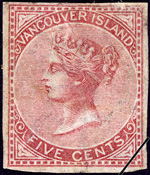Postal Impostors
Philatelists are stamp collectors. The more serious philatelists are willing to pay great sums of money to add a rare stamp to their collection. Of course, when people are willing to spend a lot of money for something, there are always dishonest and greedy people trying to trick them -- even if it means going to jail if they're caught!
The first postage stamp was issued in Great Britain in 1840 (1851 in Canada). Twenty years later, the first postage stamp forgery -- a stamp created to fool philatelists into thinking that it is a genuine one -- appeared on the market. Some forgeries are easy to spot while others are dangerously good copies.
Here are two examples of forged stamps that Library and Archives Canada has in its collection:
Here are the genuine and the forged Prince Edward Island stamps. You can probably tell which one is the real one, and which one is the fake.
The genuine stamp is engraved. This makes Queen Victoria's picture sharper. The forged stamp is a poor lithograph version of the portrait, that looks quite fuzzy.
The funny thing about this particular stamp is that the forgery is more valuable than the genuine stamp! When Prince Edward Island became a Canadian province in 1873, it sold off all of its remaining stamps at a much discounted price. This meant that over 1.5 million really cheap stamps suddenly flooded the market. Since these stamps had next to no value, forgers had no reason to make copies. And since the forged stamps are harder to find than the original, it's the forgeries that are more valuable!
Now, let's look at the work of a master forger, Jean de Sperati. He made stamp forgery his life's work. He got so good at it that his creations were just as good (and some say even better) than the real stamps. This is the case with the Vancouver Island forgery. The original stamp was issued in 1865. To make his forgery, de Sperati bleached a real, cheaper stamp from that same era. He then used a process called photolithography to make an almost perfect copy of the stamp. If you look very (and I mean very) closely at the forged stamp, you may notice a slight weakness in the bottom frame line, just below the letter "N" in "cents." There is also a small white area on the upper lip of the Queen, and the tiny lines" around her mouth and nose are a little coarser. The cancellation mark is also a forgery.
In his lifetime, Jean de Sperati forged over 500 stamps. He sometimes signed his work in pencil on the back. By 1942, de Sperati was famous and his forged stamps are often worth more than the originals.




![Counterfeit postage stamp of Queen Victoria, from Vancouver Island, [1942]](https://bac-lac.wayback.archive-it.org/web/20071125174402im_/http://data2.collectionscanada.ca/e/e001/e000009251-v2.jpg)
